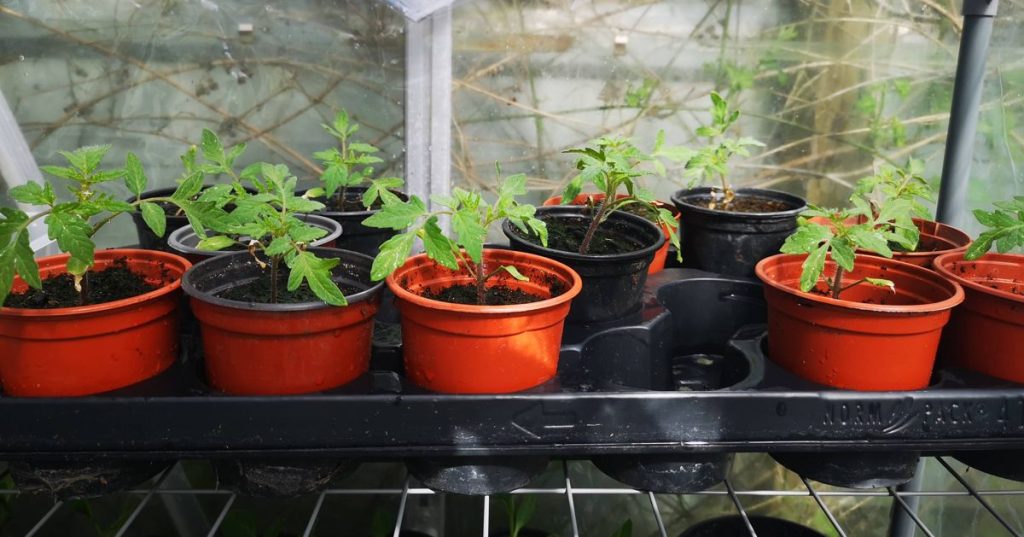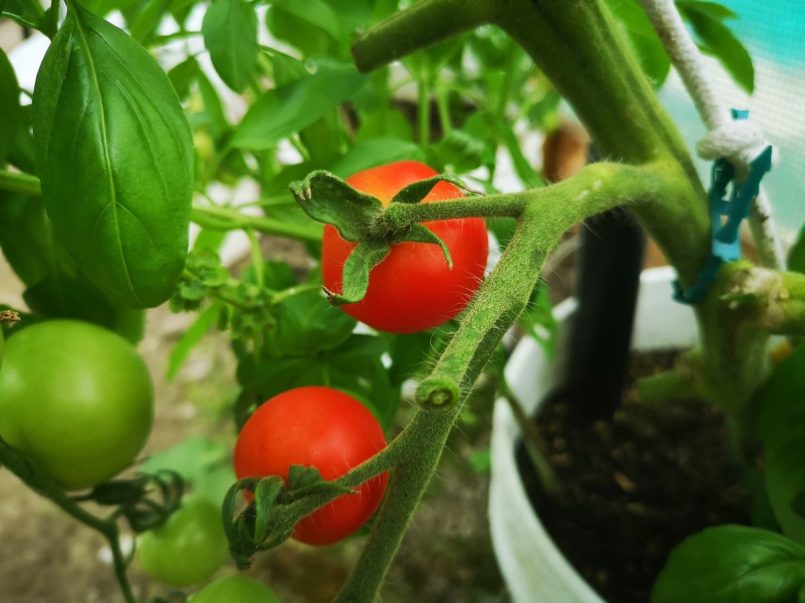Everyone enjoys a sweet and shiny red tomato, but believe me, nothing tastes as good as homegrown fresh tomatoes; the many tasteless supermarket versions offer no contest. Vine tomatoes grow vertically, so can be planted in smaller gardens where space is limited. Trailing cherry tomatoes can be grown in hanging baskets. Delicious roasted, raw, puréed, grilled or fried, they form the basis of sauces and dishes that span continents and cultures. They grow best in a greenhouse or polytunnel, but you can get outdoor varieties. Read on to find out how easily you can grow tasty tomatoes of your own.
10 reasons to grow tomatoes
- Seed packets sold in most shops.
- Seeds germinate in any compost.
- Vine plants will fit in the smallest garden or greenhouse, because they grow upwards.
- Easy to harvest – just pluck them from the stem.
- Trailing plants will grow in a planter, pot or hanging basket, so little space is needed.
- You can save tomato seeds for next year.
- They can be roasted, fried, grilled, puréed, or eaten raw. Alternatively, freeze them in soups.
- Easy to prepare – just wash and chop.
- Contain the anti-cancer antioxidant lycopene which has also been linked to heart and brain health.
- Low in calories, they contain potassium, folate, and vitamins C and K.
Our tomatoes this year – what we did
We sowed the seeds in trays placed on our windowsill on 16th March, transplanted the strongest seedlings into small individual pots on 30th March, and moved them into large pots inside the polytunnel on 5th May. From early August we have harvested ripe tomatoes.
Recommended varieties: Moneymaker (vine) and Tumbling Toms (trailing)



How you can grow tomatoes
What you’ll need:
- Tomato seeds
- Seed tray
- Small and larger individual plant pots
- Compost
- Watering can or jug
- Windowsill, greenhouse, polytunnel – somewhere protected from the weather
What you’ll do:
- In March, fill a seed tray three-quarters full with compost. Water the compost lightly.
- Arrange the seeds evenly over the compost, and try to leave at least a 1-inch gap between seeds.
- Cover seeds with compost so the tray is full. Sow more than you need.
- Water every week or so if the compost looks dry, but don’t overwater them.
- Once the seedlings have at least four true leaves (the first two leaves don’t count), carefully move them into small individual plant pots filled with compost. Keep watering them if dry.
- In early May, transplant them either into larger, deeper pots or into the ground. Water well.


Caring for tomatoes
Water regularly – at the base of the plants and increasingly as the plants grow larger. Avoid wetting the leaves and fruit. Try to maintain a consistent watering regime to avoid them drying out or becoming too saturated.
Support their growing weight – ideally fasten a long piece of rope or strong twine from the greenhouse or polytunnel framework, make knots that are spaced out all along its length, and use a tie to secure the plant to each knot as it grows. Alternatively, use canes stuck into the plant pot.

Cut off any side shoots (vine tomatoes only) – any stems that grow between the main stem and a side stem should be removed. Remember to check and snip off regularly, otherwise this will take energy away from the main growth.
Feed weekly as soon as tomatoes start forming – you will get healthier plants and more tomatoes if you regularly feed them with either tomato feed or homemade comfrey feed.

Snip off the main growing stem – do this once there are four or five trusses of flowers/fruit on the plant.
Cut off the base leaves – remove the lower leaves once the plants reach about 5 feet tall to allow for better air circulation and to direct more energy to the fruit production and ripening.

tomato production.
Harvesting tomatoes
Harvest tomatoes when they are red by simply twisting off each tomato by hand. You can eat them when they are orange but they won’t taste as sweet.
Problems
You shouldn’t encounter any problems as long as you keep them watered at a consistent rate, feed and water at the base, and support them as they grow.
Split or cracking tomatoes – still edible if eaten quickly. If skin isn’t broken, remove from the vine and ripen indoors. This is caused by inconsistent watering or temperatures.

Black marks on the base – this is called blossom end rot and is caused by a lack of calcium. Scatter finely broken eggshells around the base of the plant or add some soluble calcium tablets to the water.
Shadow rings on the skin – still edible. Caused by water or condensation dripping from above.

Tomatoes still not ripening – first try removing some more leaves. Then try harvesting the green or orange tomatoes and leave them in a sunny, warm place indoors, preferably near some ripe bananas.

Storing tomatoes
Store in the fridge vegetable drawer. Alternatively, purée them, or make them into soups and freeze.


